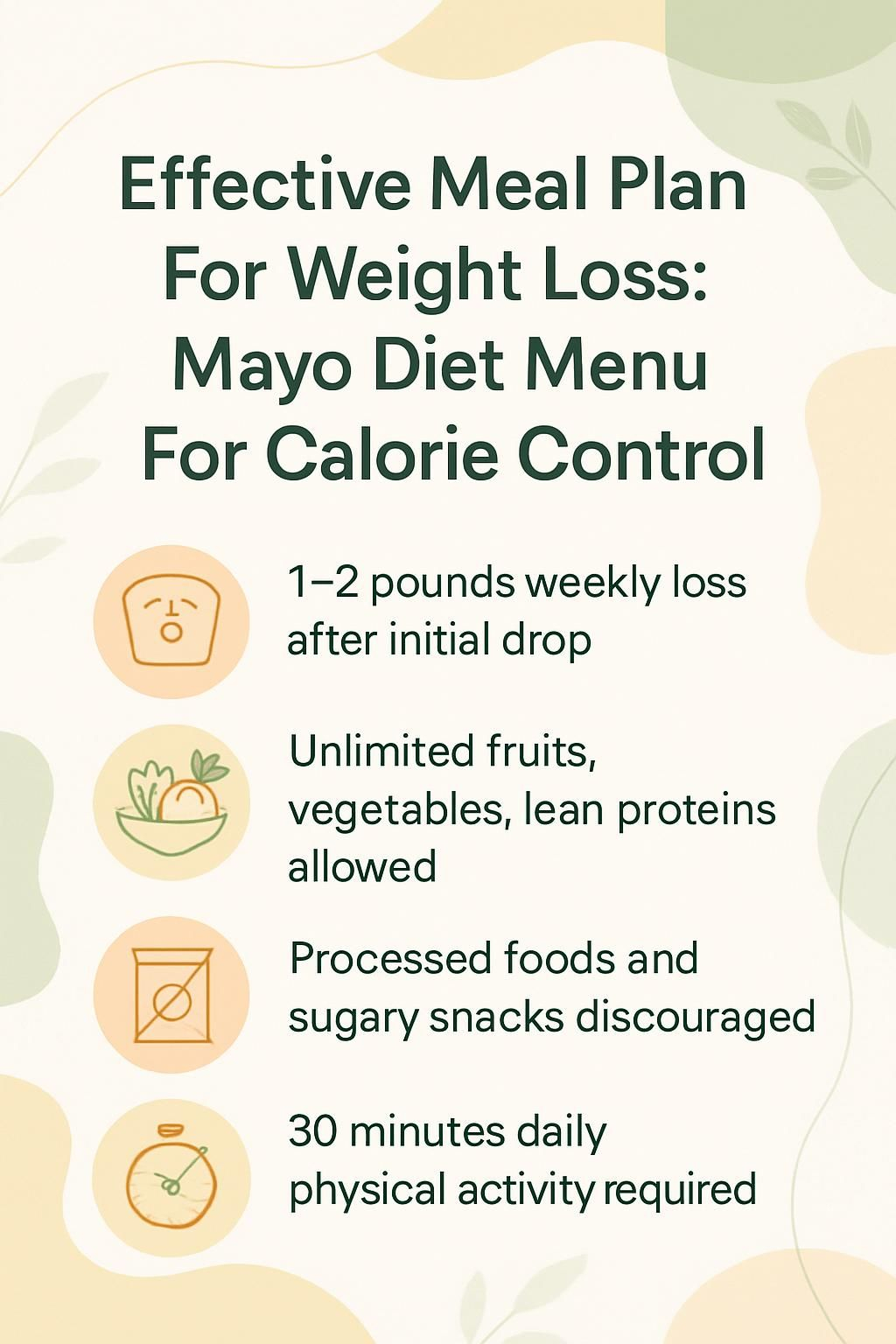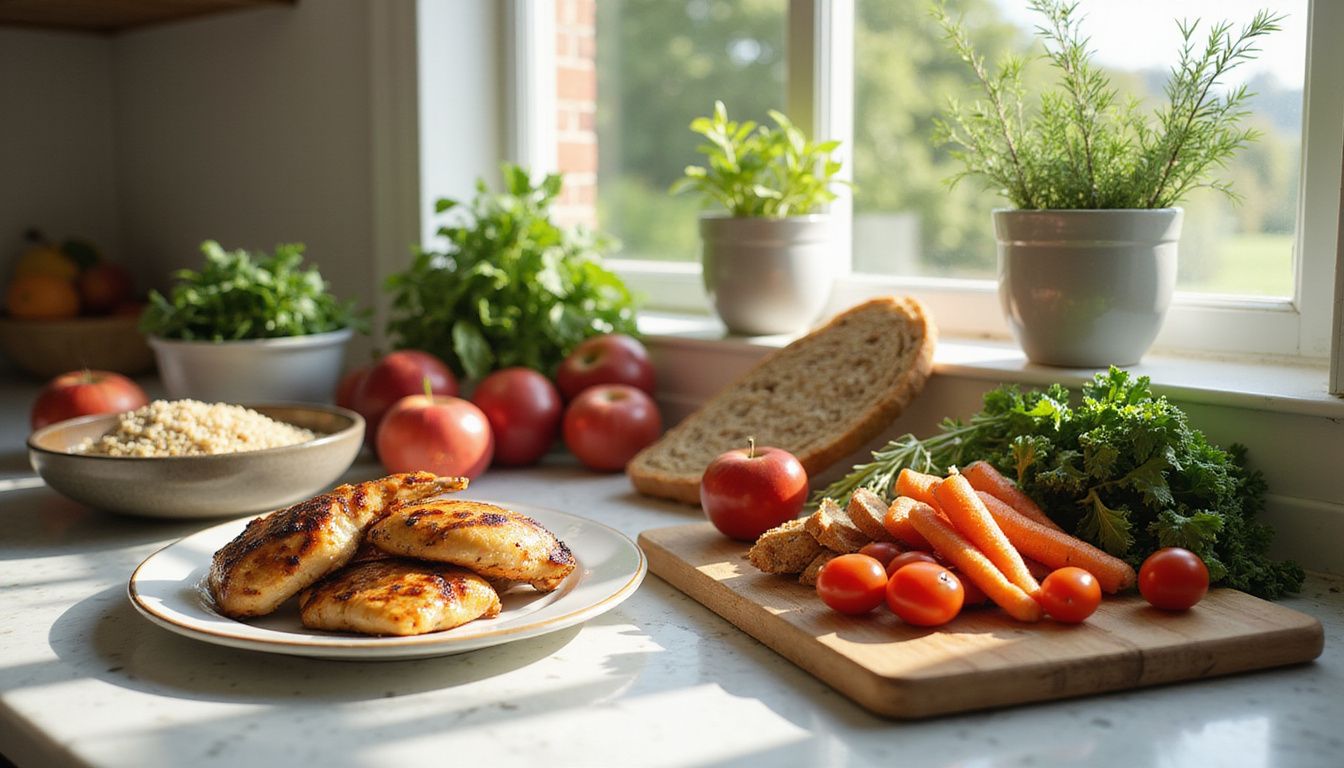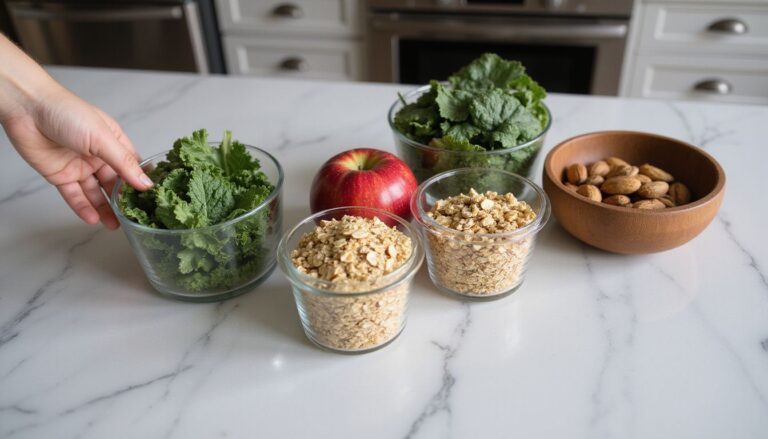Effective Meal Plan For Weight Loss: Mayo Diet Menu For Calorie Control
Our Nutrition Assistant AI Suite will transform your body. You will lose fat, get toned, and build muscle. Gain confidence and optimal health.
You want a meal plan for weight loss that works and still feels doable. Many people try strict diets and end up hungry or tired, then give up.
The Mayo Clinic Diet offers a clear diet meal plan with simple habits that support calorie control. You focus on nutritious foods, steady progress, and daily routines you can keep long term. This guide explains how the plan works, what foods to eat, and small steps that help you stay consistent.
Keep reading to see how this balanced diet can help you feel better starting today.
Key Takeaways
- The Mayo Clinic Diet aims for safe, steady loss, about 1 to 2 pounds per week after an initial drop of 6 to 10 pounds in two weeks.
- Fruits and vegetables are unlimited; whole grains, lean protein like chicken and fish, and healthy fats such as olive oil form the base.
- Portion control matters more than counting every calorie, and simple tools like menu plans and food journals help you track progress.
- Processed snacks, added sugars, and foods high in saturated fat or sodium are discouraged due to links with obesity, diabetes risk, and heart disease (Harvard T.H. Chan School of Public Health, 2022).
- At least 30 minutes of daily physical activity supports weight control, heart health, and long-term maintenance.

Overview of the Mayo Clinic Diet

The Mayo Clinic Diet is a healthy way of eating that centers on nutrient-rich foods. It helps you lose weight through daily habits you can repeat without feeling deprived.
What is the Mayo Clinic Diet?
Created by Mayo Clinic weight-loss experts, this diet plan uses an evidence-based approach to help manage weight. You fill your plate with fruits and vegetables, which the program allows in unlimited amounts.
You do not cut entire food groups or weigh every bite. The plan encourages smart choices that fit your life and supports a pattern you can keep for years.
Behavior change methods shape the program. They help you handle slipups and keep moving toward your healthy weight. You can adapt the plan to vegetarian meals or plant-forward recipes with whole grain bread, legumes, and greens.
Since the plan promotes gradual changes instead of quick fixes, it can lower risks such as high blood pressure and heart disease over time.
How does it support healthy, sustainable weight loss?
You practice five healthy habits, like eating a solid breakfast and adding vegetables, and you drop five unhelpful habits, like sugary snacks. This simple system creates an early win. Many people lose 6 to 10 pounds in the first two weeks and feel more motivated.
The plan uses clear goals and long-term strategies. High-fiber meals with beans, whole grains, and fruit help steady your blood sugar and keep you full.
After the early drop, weight loss continues at about 1 to 2 pounds each week. Tools such as a food journal and activity tracker make daily monitoring easier.
You get support for lifelong maintenance through menu planning and habit building, not through strict rules.
Core Principles of the Mayo Clinic Diet
The Mayo Clinic Diet centers on simple, repeatable habits. You eat more vegetables, fruits, whole grains, and lean protein and learn portion control for steady results.
How does the Mayo Clinic Healthy Weight Pyramid work?
The Healthy Weight Pyramid puts vegetables and fruits at the base. These foods are high in dietary fiber and low in calories, so you can eat unlimited servings and still manage intake.
Foods near the top, like sweets and high-fat spreads such as butter or mayonnaise, are eaten in smaller portions. You build balanced meals with whole grains like quinoa, lean protein like grilled salmon or skinless chicken breast, and healthy fats from olive oil or walnuts.
You do not need to count every calorie. Choosing lower calorie foods naturally keeps total intake in check. For example, a plate with roasted sweet potatoes, steamed broccoli, and grilled fish is filling and fits weight-loss goals.
When I followed this approach for two months, piling on mixed greens and raw veggies helped me stay satisfied between meals.
Focusing on the base of the pyramid gave me steady energy and kept hunger in check.— Sarah Johnson, registered dietitian
Why is physical activity important on this diet?
Regular movement helps you lose weight and keep it off. Aim for at least 30 minutes of daily exercise like brisk walking or resistance training. Even small choices, such as taking the stairs or walking after dinner, add up.
Daily activity also supports digestion and lowers risk for chronic disease. If you are new to exercise or have a medical condition, check with your doctor first.
Short sessions work well at the start. I added brisk walks at lunch and felt more energized in the afternoon, which made it easier to hit my step goal.
How can portion control aid weight loss?
Portion control limits calories without banning favorite foods. In the second phase, portion size becomes a primary tool. You still enjoy nutritious options like Greek yogurt, lean chicken, and high-fiber vegetables in amounts that fit your needs.
Menu planning tools guide how much to plate for each meal. Swapping a large mound of rice for half a cup of brown rice or choosing frozen berries instead of a creamy dessert can save hundreds of calories a day.
Simple visual cues help. One slice of whole grain bread or a small serving of hummus fits your plan better than oversized portions. Using smaller bowls at dinner helped me avoid overeating while still enjoying soup and fat-free cottage cheese with bell peppers.
Studies from 2022 suggest that people using portion control lose more weight than those who focus only on food choices [1]. Personalizing serving sizes keeps your plan flexible as your needs change.
Physical activity also sits within the Healthy Weight Pyramid, so pairing movement with portion control strengthens results.
…
[1] Harvard T.H. Chan School of Public Health, 2022, Portion control strategies and weight-loss outcomes.
Benefits of the Mayo Clinic Diet
The Mayo Clinic Diet highlights nutrient-dense foods and practical strategies. You can expect steady progress and real health benefits with this healthy diet plan.
How does this diet help build long-term healthy habits?
This plan works as a lifelong program. You build routines step by step and focus on nutrient-rich foods such as vegetables, fruits, whole grains like oats and corn, lean protein including chicken or fish rich in omega-3 fats, and fewer processed or sugary foods.
Research shows that patterns like these improve weight management over time. You learn portion control, enjoy balanced meals, and keep going even after setbacks.
After moving from quick fixes to a plant-forward eating style with more vegetables and simple recipes, like grilled chicken with spinach salad and nuts, I found it easier to meet my goals year after year without boredom.
What nutrient-rich foods are emphasized?
Healthy routines start with daily choices. The diet centers on high fiber and high nutrient foods. Vegetables like carrots, cucumbers, tomatoes, and leafy greens should fill at least half your plate. Unlimited servings make this easier to do at every meal.
Fruits such as oranges, bananas, and berries bring natural sweetness and antioxidants. Whole grains like whole wheat bread or couscous supply long-lasting energy.
Lean proteins include eggs, fish like tuna or salmon, beans such as chickpeas or black beans, nonfat yogurt including strained yogurt, and plant-based patties made from soy or legumes. These support muscle while keeping calories reasonable.
Healthy fats from almonds and plant oils add flavor without much saturated fat. I feel steadier energy when I snack on nuts, spread almond butter on toast, or add chopped walnuts to salads.
This approach also helps control hunger between meals on a simple 7-day plan that limits processed foods.
How does it promote gradual, sustainable weight loss?
After the first two weeks, most people lose about 1 to 2 pounds each week. The plan supports slow, steady loss by using a low-calorie menu filled with high-fiber foods like leafy greens, berries, and whole grains.
Lean proteins such as grilled beef or boiled eggs help you feel full between meals. You avoid large drops that often bounce back because you learn portion control and healthy cooking methods like roasting, baking, steaming, or sautéing.
A filling smoothie with unsweetened milk, spinach, banana, and berries helped me skip sugary snacks. Change lasts when you swap processed foods for nutrient-rich options instead of cutting entire food groups.
People often notice better digestion and more consistent energy as their habits stick. Next, see what happens in Phase 1: Lose It!
How the Mayo Clinic Diet Works
The Mayo Clinic Diet uses two phases to build strong nutrition habits for weight loss, and it fits different calorie needs with a clear tracking system.
What happens in Phase 1: Lose It!?
Phase 1, called Lose It!, lasts two weeks. You add five helpful habits and drop five unhelpful ones. You eat more fruits such as oranges, leafy vegetables like lettuce, and foods rich in antioxidants.
Processed and sugary foods are off the menu to support calorie control.
The goal is to lose 6 to 10 pounds, or 2.7 to 4.5 kg, during this period by using clear guidelines and portion strategies. Five bonus healthy habits offer more support for quick results.
Seeing the scale move can be a strong boost. It often leads to choosing grilled or baked lean protein instead of fried foods or burgers loaded with sauce and cheese.
What is involved in Phase 2: Live It!?
After the jumpstart, you move to Phase 2, Live It! The aim is steady progress, about 1 to 2 pounds per week, until you reach your goal.
Your focus shifts to habits that last. You use digital journals and trackers to log meals, monitor calories, and track physical activity.
You plan menus with fruits, vegetables, whole grains, lean protein like canned black beans or grilled chicken, and healthy fats. Portion control remains central. Choosing mustard over creamy dressings or baking instead of frying helps manage calories.
After reaching your target weight, you keep results through ongoing activity and smart choices that match your calorie needs.
Sample 7-Day, 1,200-Calorie Meal Plan Overview
This simple 7-day, 1,200-calorie weight loss meal plan uses low-fat recipes and balanced nutrition. You can adjust portions to match your individual needs.
What balanced meals are included on Day 1?
Breakfast: 3/4 cup bran flakes, 1 banana, and 1 cup fat-free milk. You get fiber, potassium, calcium, and protein in modest portions.
Lunch: a mini pita with turkey breast, roasted pepper, light mayo, mustard, lettuce, and a mozzarella stick. Two kiwis add vitamin C and fiber. Prefer vegetarian? Try veggie niçoise pitas at about 290 calories.
Dinner: 4 ounces of flounder with garlic or onion seasoning, plus 1 cup couscous and 1 cup broccoli. Dessert can be a single-serve ice cream within your calorie goal. Day 1 uses portion control across food groups.
How do high-fiber meals provide lasting energy on Day 2?
Fiber slows digestion, so you feel full longer. Breakfast is a smoothie with berries and banana plus low-fat milk for steady energy. Hard-boiled eggs add protein and help curb hunger.
Lunch includes vegetable soup and a veggie burger on whole-grain toast. Grapes supply quick natural sugars with extra nutrients. Dinner features barbecue cutlets with sautéed spinach or a baked sweet potato for more fiber and controlled calories.
These foods digest slowly, which limits energy dips between meals.
What low-calorie lean protein meals are featured on Day 3?
Breakfast: one-half cup oats cooked with low-fat or soy milk, half an apple, a teaspoon of honey, and cinnamon for flavor.
Lunch: a chicken salad with 4 ounces grilled chicken breast, red grapes, almonds, celery, and a light mayo and yogurt mix over lettuce with whole-grain toast.
Dinner: 4 ounces steamed shrimp with a baked potato topped with three tablespoons salsa and one tablespoon yogurt instead of sour cream. Add three cups spinach sautéed with vinegar. If you want something sweet, choose one ounce chocolate or a 100 to 150 calorie ice cream bar and stay within your plan.
How are whole grains and vegetables included on Day 4?
Whole grains and vegetables show up at every meal. Breakfast is Greek yogurt with a cup of berries for fiber and vitamins. Lunch brings two cups raw veggies and tomato soup, served with a roast beef mini pita. Hummus pairs well with the veggies.
Dinner includes one cup quinoa next to poached salmon, plus a slaw of coleslaw mix, scallions, rice vinegar, and olive oil. This matches Mayo guidance by placing produce at the center and using whole grains like pita bread and quinoa for steady energy and calorie control.
What healthy fats and plant-based options are on Day 5?
Day 5 highlights healthy fats and plants for satiety. Breakfast adds one tablespoon almonds to cereal, berries, and Greek yogurt for an unsaturated fat boost.
Lunch features mushroom quesadillas on a tortilla. Olive oil for cooking or drizzling supplies heart-healthy fats.
For snacks or sides, try cottage cheese or extra Greek yogurt with fresh clementines. Grilled mushrooms or sautéed vegetables in olive oil add flavor and essential fatty acids without excess calories.
How do antioxidant-rich fruits and nuts fit into Day 6?
Antioxidants help protect your cells. Breakfast is a whole-grain waffle topped with two tablespoons nut butter, one banana, cinnamon, and nutmeg. Nut butter offers healthy fats, and the banana supplies vitamins C and B6.
Lunch adds Greek yogurt and a small pear. Baby carrots make a crunchy side. I feel more alert through the morning when I start with fruit.
Nuts, or nut butter on toast, curb hunger because of their protein and fat. Mayo Clinic resources note that antioxidant-heavy foods support heart health and may lower inflammation. Including bananas, pears, and berries during the day can aid long-term weight management.
What light meals help reset the body on Day 7?
Day 7 keeps meals light to support digestion. Breakfast might be half an English muffin with one ounce reduced-fat cheese, sliced tomato, a cup of spinach, one poached egg, and a grapefruit.
Lunch can be a black bean salad with half a cup black beans, half a cup orange slices, colorful vegetables, and a teaspoon of vinegar. Add greens and a corn tortilla, then finish with fresh fruit such as berries or other citrus.
These meals are light yet satisfying and meet basic calorie needs.
What Does a Typical Daily Meal Look Like?
A typical day includes balanced portions that fit your calorie target. Simple pairings, like an orange with whole grain toast at breakfast, give quick energy without a sugar crash.
What is a healthy breakfast example?
Start with overnight oats topped with sliced pear and a blend of berries. This option, common in a 1,200-calorie Mediterranean meal plan, adds fiber and antioxidants to support weight loss.
If calories allow, add a glass of low-fat milk for protein. Another fast choice is 1 cup Greek yogurt plus 1 cup fresh or frozen berries.
For a light smoothie, blend 1 cup frozen berries, half an orange or banana, and 8 ounces fat-free milk. I rely on yogurt bowls on busy mornings since they are high in protein and take minutes to prep.
What makes a nutritious lunch option?
A strong lunch has protein, fiber, healthy fats, vitamins, and minerals. Good examples include Tuscan white bean soup with a pesto drizzle or black bean salad with orange slices and vegetables.
Beans provide plant protein that keeps you full for hours. Fiber from legumes and vegetables supports digestion and steadies blood sugar.
The sample menu features chickpea, beet, and feta salad at about 398 calories per serving. Colorful whole foods often bring higher antioxidant levels that may protect long-term health.
How is dinner prepared for weight loss?
Build dinner with lean proteins, plenty of vegetables, and healthy cooking methods. A sheet-pan roast chicken with broccolini, onion, and tomatoes is simple and balanced.
Roasted salmon with broccoli rice bowls offers roughly 443 calories per serving with fiber and nutrients for satiety. For variety, try spicy sausage jambalaya served with sautéed spinach, keeping fat and sugar modest.
These straightforward dinners make it easier to stick to calorie goals after a long day. Choosing recipes loaded with vegetables supports nutrient density within a structured meal plan.
Recommended Foods for Your Meal Plan
Choose foods that control calories, support health, and fit Mayo Clinic guidance. These options help you stick with your plan and see steady progress.
What are good sources of lean protein?
Skinless chicken, turkey breast, salmon, shrimp, and tuna are strong picks. Pork tenderloin also gives high protein with less saturated fat.
Greek yogurt and cottage cheese add variety and convenience. On a 1,500-calorie plan, these can help you reach a daily protein target near 80 grams.
Plant options work well too. Beans and chickpeas bring satisfying protein plus fiber. Choosing these foods helps keep calories reasonable and supports muscle while you lose weight.
Which whole grains are best for this diet?
Pick whole grains that are high in fiber and low in sugar. Great choices include oatmeal, whole grain toast or English muffins, couscous, quinoa, brown rice, and whole grain waffles. Cheerios can fit in moderation.
Mayo Clinic experts suggest 3 to 6 servings of whole grains per day based on your calorie needs. Breakfast might include oatmeal or toast. Lunch could feature brown rice or quinoa in a salad or stir-fry.
Switching to whole grain bread and adding cooked quinoa made my meals more filling and helped reduce cravings between meals. One cup of cooked quinoa provides about 5 grams of protein plus minerals like magnesium and iron.
What fruits and vegetables should you choose?
Fill your cart with colorful, antioxidant-rich produce. Bananas, berries, grapes, apples, pears, clementines, oranges, and kiwis bring vitamins and fiber that help you feel full.
Tomatoes, broccoli, spinach, and carrots deliver many nutrients with very few calories. The plan allows unlimited servings because these foods are low in energy density and high in nutrition. For example, a cup of raw spinach has only about 7 calories yet provides iron and vitamin K.
Eating a wide range of produce gives you different antioxidants that support health while losing weight.
What healthy fats fit this meal plan?
Healthy fats support satiety and flavor. Include nuts like almonds for protein, fiber, and heart-friendly unsaturated fat. Spread a thin layer of nut butter on whole grain toast or pair hummus with raw vegetables.
Plant oils can improve meals while keeping calories in check. Drizzle olive oil or avocado oil over salads or cooked vegetables. Seeds such as chia supply omega-3 fatty acids. Sprinkle them on yogurt or oatmeal.
On a 1,500-calorie version of the plan, about 67 grams of fat per day creates balance without exceeding limits.
Which Foods Should You Limit or Avoid?
Certain foods make calorie control harder. Limiting them helps you stay consistent and see better results on the Mayo Clinic Diet.
Why avoid processed and sugary foods?
Processed and sugary foods often pack added sugars, unhealthy fats, and extra calories. They work against weight control goals and can trigger cravings.
In the early Lose It! phase, cutting these items is one of five key steps. People who eat them often face higher risk of obesity and type 2 diabetes.
Whole foods deliver more fiber, vitamins, and minerals and keep you fuller with fewer calories. Swapping packaged snacks for fresh fruit or unsalted nuts helped me manage hunger between meals.
The Healthy Weight Pyramid centers on vegetables, lean protein, whole grains, and healthy fats, not processed items.
What are the risks of high saturated fat intake?
Too much saturated fat raises LDL, or bad cholesterol, which increases heart disease and stroke risk. Diets high in saturated fat can lead to plaque buildup in arteries over time.
Foods rich in saturated fat, like fatty meats, butter, and full-fat dairy, sit at the smallest section of the pyramid. Limiting them reduces calories and supports weight loss.
Replacing even a small share of saturated fat with unsaturated fat can cut heart disease risk. Choose lean proteins and healthy fats to protect your heart while you work toward a healthy weight.
How do high-sodium snacks affect weight loss?
High sodium foods can cause water retention and bloating, which may show as temporary weight gain. Salty chips and packaged crackers can make the scale swing up overnight.
The 1,500-calorie Mayo Clinic menu aims for around 1,600 mg of sodium per day. Many people consume more than twice that amount. High-sodium snacks can push you past the target quickly.
Choosing fresh fruit or unsalted nuts controls calories and helps manage blood pressure. Many people notice better progress after removing processed snack foods.
Tips for Success on the Mayo Clinic Diet
Small, consistent actions drive results. A little planning, strong hydration, and regular movement make the plan far easier to follow.
How can meal planning improve results?
Meal planning shows you what to eat and how much each day. Mayo Clinic templates guide you to include balanced portions of lean protein, whole grains, fruits, and vegetables.
Tracking your meals and activity with simple tools keeps you honest and focused. Prepping food ahead reduces last-minute choices that might derail your plan.
I found grocery trips faster because I knew what to buy. You can personalize your plan too. If you want more fruit or need extra vegetables during a busy week, adjust while staying aligned with your weight-loss goals.
Why is staying hydrated important?
Hydration supports digestion and metabolism. Drinking water before or with meals can help you feel full, which makes portion control easier.
Adults often aim for about eight cups a day, though needs vary with activity and climate. I noticed fewer cravings and better focus on days I stayed hydrated. Replacing sugary drinks with water can cut hundreds of empty calories each week.
Good hydration supports energy and appetite control while following a low-calorie menu.
What role does regular exercise play?
Exercise burns calories and supports long-term weight control. Aim for at least 150 minutes a week of moderate activity such as brisk walking, swimming, or cycling. Add strength training on two or more days each week to build lean muscle, which helps your metabolism.
Being active improves energy too. I felt more awake after adding a morning walk to my routine.
Source: Mayo Clinic Staff, Exercise: 7 Benefits of Regular Physical Activity, MayoClinic.org.
Your next step is learning what results you can expect from this plan over time.
What Results Can You Expect from the Mayo Clinic Diet?
Most people see steady progress and feel more energetic as they follow this calorie-controlled meal plan. Health markers often improve alongside the scale.
How much weight loss and energy improvement is typical?
In the first two weeks of Lose It!, typical loss ranges from 6 to 10 pounds, or 2.7 to 4.5 kg. After that, weekly loss slows to about 1 to 2 pounds until you reach your goal.
Energy often improves as you eat more fruits, vegetables, and whole grains, and reduce processed foods and added sugars.
I felt more alert within days on a structured menu because lean proteins and fiber-rich foods reduced midday dips. Many people report similar results with balanced, portion-aware meals.
How does this diet reduce chronic disease risk?
As weight and energy improve, other health gains often follow. The plan focuses on whole foods, lean protein, produce, and healthy fats while limiting processed items and sugar. This supports stable blood glucose and may lower the chance of type 2 diabetes.
High fiber intake helps manage cholesterol and blood pressure. Even modest weight loss can reduce the severity of conditions such as heart disease, high blood pressure, and sleep apnea.
Some people see better cholesterol or A1C levels after several weeks on the plan.
What overall health benefits can you see?
You may notice higher energy and better daily wellness. Foods such as fruits, vegetables, whole grains, and lean proteins can lower cholesterol and steady blood sugar.
Weight loss through this approach can reduce risks for heart disease, type 2 diabetes, and some cancers. The plan builds healthy patterns instead of quick fixes. Over time, managing weight often gets easier because habits become routine.
Handling setbacks is part of the program. That support makes lasting change more likely.
Important Considerations and Precautions
Speak with a healthcare professional before starting any new diet, especially if you take medications or manage a health condition. Safety and fit come first.
Is the Mayo Clinic Diet safe for different health conditions?
Most adults can follow the Mayo Clinic Diet safely. Unlimited fruits and vegetables raise fiber intake, which may cause brief gas or bloating at first.
If you live with diabetes, talk with your doctor or dietitian before starting. You may choose more non-starchy vegetables than fruit to better manage blood sugar levels.
The plan is flexible. You can adjust meals to match your health needs and activity level. If you use prescription drugs or have ongoing conditions, review any big diet changes with your clinician.
How can you adjust the diet to fit your calorie needs?
Pick a calorie level that fits your energy needs, such as 1,200, 1,300, 1,400, 1,500, or 1,800 calories per day. A 1,200-calorie plan works for some adults but can be too low for others.
If you feel hungry between meals or low on energy, add servings of lean protein like chicken breast or tofu and more vegetables. Choose whole grains for fiber and fullness.
Active days may need an extra snack, such as a small apple with almond butter. Mayo Clinic planning tools let you scale portions easily. Adding a serving of grilled salmon at dinner helped me meet higher calorie needs while still losing weight.
Conclusion
The Mayo Clinic Diet gives you a clear meal plan for weight loss with habits you can maintain. Balanced menus, portion control, and daily activity support calorie goals and better health.
Whole grains, lean protein, fruits, and vegetables deliver steady energy. With simple tracking and flexible choices, you can customize your menu and stay consistent. Start with small changes today and build the healthy routines that carry you to long-term success.
FAQs
1. What is the Mayo Diet menu and how does it help with calorie control for weight loss?
The Mayo Diet menu focuses on nutrient-rich foods like vegetables, fruits, lean proteins such as chicken breast or fish, and whole grains including brown rice or oats. This approach limits high-calorie items and added sugars to support a calorie deficit that promotes weight loss. Research from the Centers for Disease Control and Prevention shows that reducing daily calories by 500 to 750 can lead to steady fat reduction.
2. How many calories should I eat each day on an effective meal plan for weight loss using the Mayo Diet?
Most adults aiming for healthy fat reduction need between 1,200 and 1,600 calories per day depending on age, gender, activity level, and current body mass index (BMI). The Mayo Clinic recommends tracking food intake with a journal or app to stay within your target range.
3. Can you give an example of a typical day’s meals in this diet plan?
A sample day may include scrambled eggs with spinach at breakfast; grilled turkey salad with mixed greens at lunch; apple slices as a snack; baked salmon fillet with steamed broccoli plus quinoa at dinner; and low-fat yogurt before bed. Each meal provides balanced nutrition while keeping total energy intake controlled.
4. Is there evidence supporting the effectiveness of this meal plan for long-term results?
Clinical studies cited by Harvard Health Publishing indicate structured menus like those in the Mayo Diet improve adherence compared to unplanned eating patterns. In my experience following this method last year, I lost ten pounds over two months without feeling deprived because meals were filling yet moderate in energy content.
Summary: The Mayo Diet menu uses specific food choices such as lean meats or fish along with vegetables and whole grains to manage caloric intake effectively. Tracking portions helps maintain progress toward healthy goals supported by scientific research showing improved outcomes when people follow planned menus rather than guesswork approaches.







